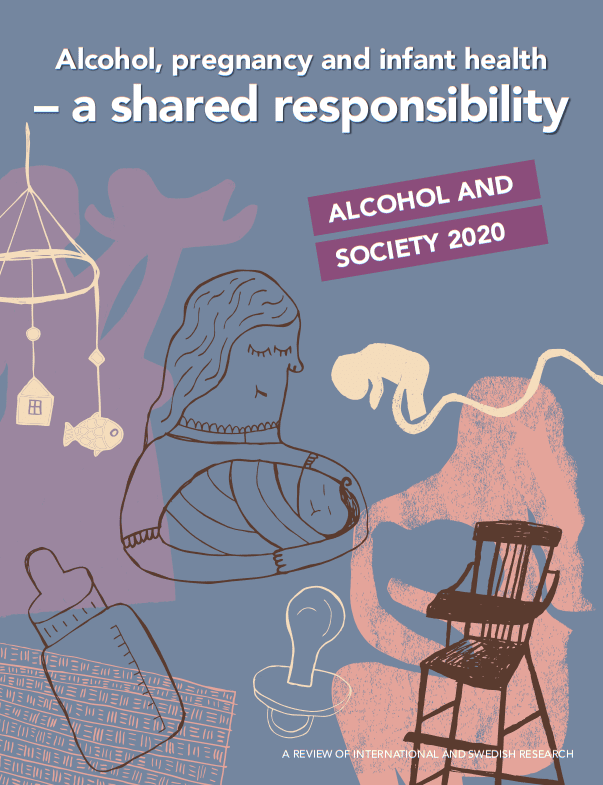
IOGT-NTO in Sweden has released a new report about alcohol harm during pregnancy and for infant health.
The report is a review of international studies on alcohol, pregnancy and infant health conducted by some of the world’s leading alcohol researchers led by Dr. Harold Holder.
ALCOHOL, PREGNANCY AND INFANT HEALTH – A SHARED RESPONSIBILITY
Of all the lifestyle choices people make in connection with a pregnancy, there is nothing more important to the child’s future health and development than the choices the parents make about alcohol.
A key finding from the report, that is a collaboration between IOGT-NTO, Gothenburg University, SFAM, Actis, Alcohol & Society, MHF, Hela Människan, the Swedish Free Churches, and the Swedish Blue Cross, is that preventing alcohol harm before, during and after pregnancy is a shared responsibility, including mother AND father. It is an important issue of equality.
Foetal damage is one of the clearest examples of the second-hand harm caused by alcohol (harm to others). The cost of FAS (foetal alcohol syndrome) in Sweden is estimated at SEK 14 billion per year. The biggest share of these costs derive from support provided by society to people living with the consequences of FAS. The report shows, for instance that the effects of prenatal alcohol exposure on foetal development are stronger than those from tobacco use, use of other psycho-active substances and exposure to other hazards such as lead and radiation.
Many professionals and experts in the field of public health in Sweden have been calling for increased awareness concerning the risks of alcohol. The report aims to provide much needed information to help parents prevent and reduce risks of alcohol harm.
The report focuses on the shared responsibility of both parents and the gender equality aspect of in terms of pregnancy and infant health.
Some key facts from the report
- Fathers’ alcohol consumption before pregnancy can cause harm to the fetus and possibly to future generations as alcohol changes the sperm’s genetic mass.
- The pregnant person’s likelihood of consuming alcohol during pregnancy increases if the partner consumes alcohol, especially if the partner is at risk of or has a heavy alcohol consumption.
- Despite this, very few partners change their alcohol use during pregnancy.
- Men’s heavy episodic alcohol use is linked to partner violence during a pregnancy.
Executive Summary – highlights
Consequences of alcohol exposure in connection to pregnancy
- Alcohol exposure in pregnancy is the most common cause of preventable cognitive deficits among children in Sweden and globally, affecting an estimated 1% to 5% of live births each year.
- The incidence of FAS in Sweden has been estimated at 0.1% to 0.3% of all births, or 100-300 cases per year, and for FASD 1% to 3%.
- The cost of FAS to Swedish society is conservatively estimated at €1.4 billion per year.
- Even though the brain is the organ most severely impacted by prenatal alcohol exposure, abnormalities within the heart, kidney, liver, gastrointestinal tract, and the endocrine system can also occur.
- Possible causal mechanisms include alcohol-induced brain cell death and damage to the DNA of immature male and female reproductive cells, causing changes which can potentially last for generations.
Alcohol use in the time surrounding pregnancy
- The natural inclination is to perceive alcohol and pregnancy as a problem restricted to pregnancy, and a problem restricted to women.
- Neither is true.
- The effects of alcohol on pregnant women and their offspring are related to the alcohol use of both men and non-pregnant women in the general population.
- Over 80% of Swedish women consume alcohol during the year prior to pregnancy and 14% consume alcohol at heavy levels. Overall, few women reduce consumption prior to pregnancy recognition.
- Male alcohol use in the pre-conception period may adversely affect the foetus and possibly subsequent generations through genetic modification of sperm.
Evidence for effective policies
- Policies that restrict the availability, affordability and marketing of alcohol have been shown to effectively reduce heavy alcohol use (e.g., binge alcohol use) and alcohol-related harms in the general population. This includes alcohol consumption among those of reproductive age and effects on pregnancy and infant health have been demonstrated.
- Evidence of the potential risks of adverse outcomes associated with alcohol use during pregnancy should be widely promoted to the general population to support informed decision-making by policymakers and consumers.
- Guidelines in many high-income countries advocate abstinence from alcohol as the safest course throughout pregnancy.
- There is mixed evidence for effects of low-dose alcohol consumption in pregnancy (i.e., ‘moderate’ alcohol use) from a variety of human and animal studies. On balance, however, the evidence for effects of low-dose alcohol consumption in pregnancy suggests that abstinence is the safest choice.
The report’s key recommendations
- Policies which reduce the availability, affordability and marketing of alcohol are needed to sustain a low risk environment for alcohol-related birth abnormalities.
- There is a shared responsibility for society at large and healthcare providers to raise awareness of the risks of prenatal alcohol exposure and provide support to pregnant women and their partners to manage these risks and their consequences.
- Persons planning a pregnancy, women as well as their partners, can improve the probability of a healthy pregnancy outcome by abstaining or minimise alcohol exposure.
- It is safest to abstain from any alcohol consumption during pregnancy. Partners may also choose to abstain from alcohol consumption during this period, and if they choose to continue alcohol use they should do so within low-risk guidelines.
- It is also safest to avoid alcohol exposure while breastfeeding. Those who choose to consume alcohol during breastfeeding should limit consumption to 1 standard alcoholic drink, consumed 2 hours prior to breastfeeding.
- An expert national centre should be established in Sweden charged with developing strategies to reduce prenatal alcohol exposure, monitor prevalence of exposure and provide training in screening and treatment.
Citation
Andreasson S, Chikritzhs T, Dangardt F, Holder H, Naimi T, Stockwell T. (2020). Alcohol and Society 2020: Alcohol, pregnancy and infant health – a shared responsibility. Stockholm: Swedish Society of Nursing, SFAM, SAFF, CERA & IOGT-NTO.

